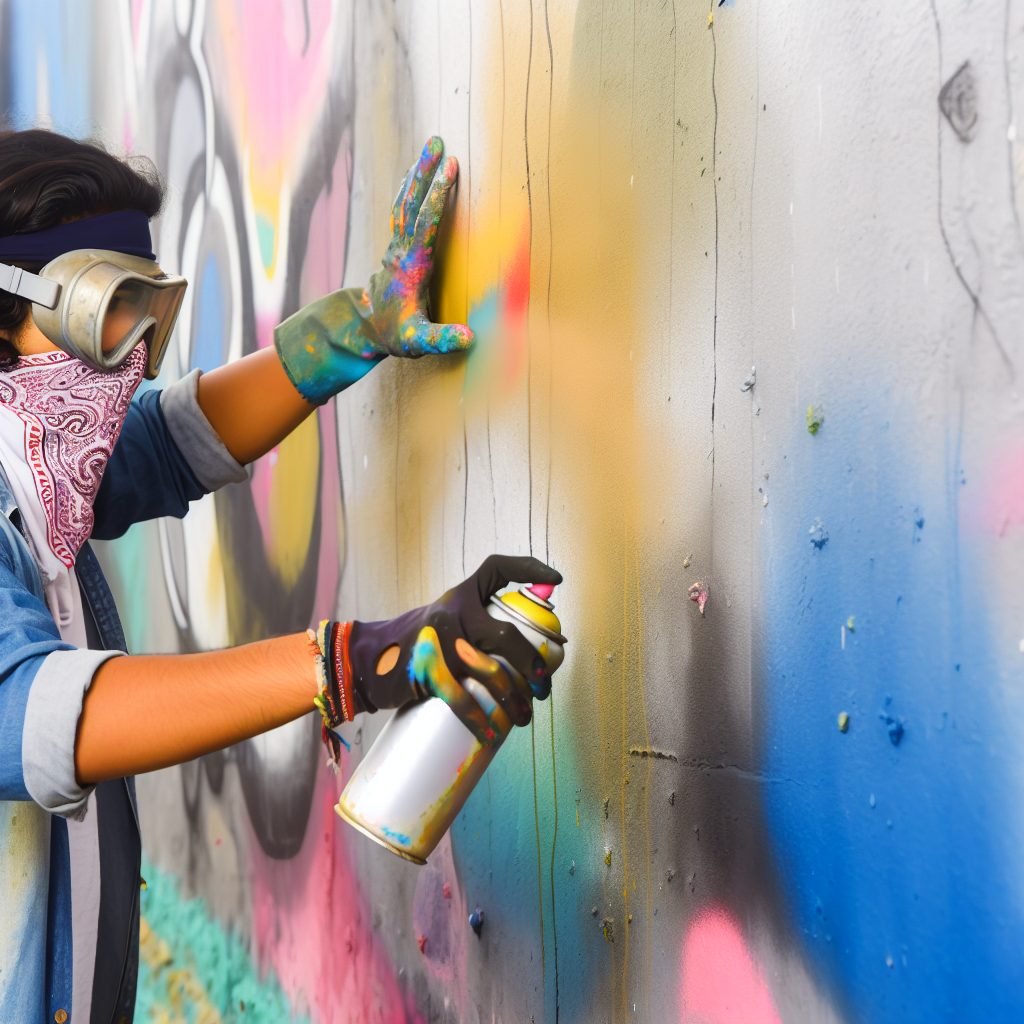Introduction:
It is crucial to achieve a professional finish with spray paint to ensure a polished and high-quality result.
In this blog post, we will cover the essential steps to help you achieve this level of finishing.
Choosing the Right Spray Paint
When it comes to achieving a professional finish with spray paint, one of the key factors to consider is selecting the right type of spray paint for your project.
Different types of spray paint are available on the market, each designed for specific purposes.
It is essential to choose the right spray paint to ensure the best results.
Different Types of Spray Paint Available:
- Aerosol Spray Paint: This is the most common type of spray paint and is suitable for a wide range of projects.
- Acrylic Spray Paint: Ideal for use on surfaces like plastic, metal, and wood, as it dries quickly and provides a durable finish.
- Gloss Spray Paint: Gives a shiny finish and is commonly used on metal, plastic, and wood surfaces.
- Matte Spray Paint: Provides a non-reflective finish, perfect for achieving a more subtle look.
- Primers: Used as a base coat to prepare surfaces for painting and improve adhesion and durability.
Importance of Selecting the Right Spray Paint:
Choosing the right spray paint is crucial for achieving a professional finish because using the wrong type of paint can result in a subpar outcome.
For example, using a glossy spray paint on a surface that requires a matte finish can lead to an unappealing result.
Additionally, selecting the appropriate paint ensures better adhesion, durability, and overall quality of the finished product.
Tips on How to Choose the Right Spray Paint:
- Consider the Surface: Different spray paints are designed for specific surfaces, so make sure to choose one that is compatible with the material you are painting.
- Choose the Finish: Decide whether you want a glossy, matte, or satin finish and select the spray paint accordingly.
- Read the Label: Check the label on the spray paint can for information on compatibility, coverage, drying time, and other important details.
- Test Before Use: To ensure the paint adheres properly and achieves the desired finish, it is a good idea to test the spray paint on a small inconspicuous area before applying it to the entire surface.
- Consider the Project Requirements: Take into account the specific requirements of your project, such as weather resistance, heat resistance, and indoor or outdoor use, and choose a spray paint that meets those needs.
By following these tips and selecting the right spray paint for your project, you can achieve a professional finish that is durable, long-lasting, and visually appealing.
Remember that the quality of the paint you use plays a significant role in the overall outcome of your spray painting project.
So, take the time to choose the right spray paint, and you’ll be on your way to achieving a flawless finish.
Importance of Properly Preparing the Surface
Before you start spraying paint on any surface, it is important to make sure that the surface is clean and free of any dirt, dust, or grease.
If the surface is not properly prepared, the paint may not adhere properly, resulting in a patchy or uneven finish.
Steps to Clean and Prime the Surface
- Start by cleaning the surface with a mild detergent and water to remove any dirt or grease.
- Scrub the surface with a sponge or brush to ensure that it is completely clean.
- Rinse the surface thoroughly with clean water and allow it to dry completely before moving on to the next step.
- Once the surface is clean and dry, apply a coat of primer to help the paint adhere better and create a smooth finish.
- Make sure to use a primer that is suitable for the surface you are painting, whether it is metal, wood, plastic, or another material.
- Allow the primer to dry completely before applying the spray paint.
Tips for Ensuring a Smooth and Even Surface for Painting
- Use sandpaper to smooth out any rough patches or imperfections on the surface before painting.
- Make sure to sand in a circular motion to avoid creating visible scratch marks on the surface.
- Wipe down the surface with a tack cloth to remove any dust or debris before priming and painting.
- Work in a well-ventilated area when painting to ensure proper air circulation and to prevent the fumes from building up.
- Hold the spray paint can at the recommended distance from the surface to achieve an even spray pattern and prevent drips or runs.
- Apply multiple thin coats of paint, allowing each coat to dry completely before applying the next one, to achieve a smooth and even finish.
By following these steps and tips for preparing the surface before spray painting, you can ensure that you achieve a professional finish every time.
Taking the time to properly prepare the surface will result in a smooth, even coat of paint that looks great and lasts longer.
Gain More Insights: Veterans Transitioning into Welding Careers in the United States
Use Proper Technique:
When it comes to achieving a professional finish with spray paint, proper technique is key.
Here are some tips to help you master the art of spray painting:
Proper technique for spray painting:
- Start by shaking the can vigorously for about a minute to ensure proper mixing of the paint.
- Hold the can upright and about 6-8 inches away from the surface you are painting.
- Use smooth, even strokes to apply the paint, overlapping each stroke slightly for even coverage.
- Apply multiple thin coats rather than one thick coat to prevent drips and runs.
Tips for achieving even coverage and avoiding drips:
- Keep your hand moving at a consistent speed to avoid pooling of paint in one area.
- Work in a well-ventilated area to prevent overspray and ensure proper drying of the paint.
- If you notice any drips or runs, wait for the paint to dry completely before sanding and reapplying.
The importance of distance and angle while spraying:
- Maintain a consistent distance of 6-8 inches between the can and the surface for even coverage.
- Adjust the angle of the can based on the shape of the object you are painting to ensure full coverage.
- Spray in short bursts rather than holding down the nozzle continuously to control the amount of paint applied.
By following these proper techniques, you can achieve a smooth, professional finish with spray paint on any surface.
Practice makes perfect, so don’t be discouraged if it takes a few tries to master the art of spray painting!
Transform Your Career Today
Unlock a personalized career strategy that drives real results. Get tailored advice and a roadmap designed just for you.
Start NowYou Might Also Like: Post-pandemic Welding: Changes and Trends in the US Market
Practice on Test Surface:
Practicing on a test surface before starting the project is crucial for achieving a professional finish with spray paint.
It allows you to familiarize yourself with the spray paint and adjust your technique accordingly.
- Importance of practicing on a test surface before starting the project:
- Tips for testing the spray paint and adjusting technique:
- How to use the test surface to perfect the final finish:
Testing the spray paint on a small, inconspicuous area first helps in understanding how the color looks on the surface and how the spray nozzle functions.
Hold the can at a consistent distance from the surface, typically 6-8 inches, and spray in short, even strokes.
Test different pressures on the nozzle to control the amount of paint being applied.
Once you have tested the spray paint and adjusted your technique, use the test surface to experiment with different angles and distances.
This will help you determine the ideal method for achieving a smooth and professional finish on your actual project.
Explore Further: Navigating the American Welding Society (AWS) Certification Path
Allow for Proper Drying Time
It is crucial to allow the spray paint to dry properly between coats to achieve a professional finish.
Here are some tips for ensuring the proper drying time in different weather conditions:
- Wait for the recommended time between coats as instructed on the spray paint can.
- Avoid painting in humid or cold conditions as it can slow down the drying process.
- For optimal drying, choose a well-ventilated area with moderate temperature and low humidity.
- Use a fan or hairdryer on the cool setting to speed up drying, but do not use high heat.
- Do not touch or handle the painted surface until it is completely dry to avoid smudges or imperfections.
By allowing for proper drying time, you can ensure a smooth and flawless finish on your spray-painted project.
Discover More: Top Welding Equipment Brands and Tools Preferred in the US

Achieving a Professional Finish with Spray Paint
When it comes to achieving a professional finish with spray paint, applying multiple thin coats is key.
Benefits of Applying Multiple Thin Coats:
- Enhanced durability and longevity of the paint job
- Reduced chances of dripping or running paint
- Smooth and even coverage on the surface
Tips for Achieving a Professional Finish with Multiple Thin Coats:
- Shake the spray paint can thoroughly before each coat
- Hold the can at the recommended distance from the surface
- Overlap each pass slightly to avoid missed spots
- Work in a well-ventilated area to prevent fumes inhalation
- Avoid painting in extreme weather conditions to ensure proper drying
How to Avoid Over-spraying and Build-up of Paint by Applying Thin Coats:
- Start spraying before reaching the surface and continue past it
- Maintain a steady and consistent speed while spraying
- Keep the can moving to prevent pooling of paint in one spot
- Apply light pressure on the nozzle for a fine mist of paint
- Allow each coat to dry completely before applying the next one
By following these tips and techniques, you can achieve a professional finish with spray paint by applying multiple thin coats effectively.
Finish with a Clear Coat:
Applying a clear coat is crucial for protecting the finish from weather or wear.
Choose a clear coat that is compatible with the type of spray paint used.
Make sure the clear coat is designed for the specific surface you are painting.
Look for a clear coat that offers UV protection to prevent fading over time.
Opt for a high-quality clear coat to ensure a durable and professional finish.
Transform Your Career Today
Unlock a personalized career strategy that drives real results. Get tailored advice and a roadmap designed just for you.
Start NowImportance of Applying a Clear Coat:
Applying a clear coat is essential for protecting the surface and preserving the color of the spray paint.
The clear coat acts as a barrier against UV rays, moisture, and other environmental factors that can cause the paint to fade or peel over time.
It also provides a glossy or matte finish, depending on the type of clear coat used.
By applying a clear coat, you can ensure that your spray paint project maintains its professional appearance for years to come.
Tips for Choosing the Right Clear Coat:
- Check the compatibility of the clear coat with the type of spray paint you used.
- Select a clear coat designed for the specific surface you are painting.
- Look for a clear coat that offers UV protection to prevent color fading.
- Choose a high-quality clear coat for a durable and long-lasting finish.
- Consider the sheen of the clear coat (glossy, satin, or matte) for the desired look.
How to Apply the Clear Coat:
- Prepare the surface by ensuring it is clean, dry, and free of any dust or debris.
- Shake the clear coat can vigorously to ensure proper mixing of the formula.
- Hold the can of clear coat 8-12 inches away from the surface to prevent drips or runs.
- Spray a light, even coat of clear coat over the painted surface, using smooth and overlapping strokes.
- Allow the clear coat to dry completely between coats, following the manufacturer’s instructions.
- Apply multiple coats of clear coat for added protection and a more durable finish.
- Let the clear coat cure for at least 24 hours before handling or exposing the surface to moisture.
Achieving a Professional Finish with Spray Paint
Achieving a professional finish with spray paint is easier than you think.
By following these simple steps, you can elevate your DIY projects to a whole new level.
Remember to prepare your surface properly, apply thin coats, and use even strokes to avoid drips and runs.
Allow for proper drying time between coats and consider using a clear topcoat for added protection.
Always practice on a scrap piece before tackling your main project to get a feel for the technique.
Don’t rush the process and take your time to ensure a flawless finish.
I encourage you to try out the tips and techniques shared in this post.
With a little practice and patience, you’ll soon be achieving professional results with spray paint like a pro.
Happy painting!
Additional Resources
Professional BACKYARD Paint-Job Using Only Spray Cans …
Is it really possible to get a smooth glossy finish with any spray paint …




